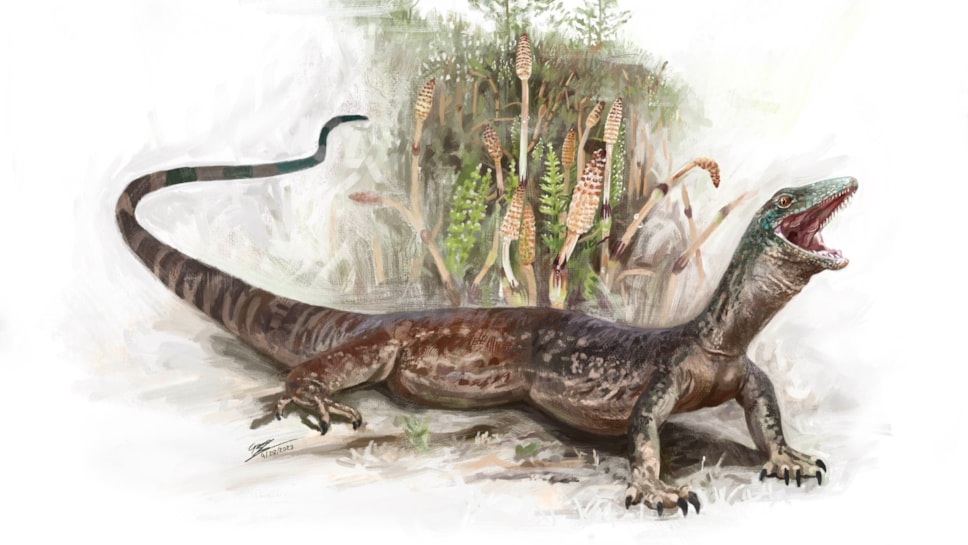
Fossil discovery reveals new species of fanged reptile that once roamed Scotland
A fossil discovered on the Isle of Skye has revealed a new species and family of Jurassic reptile linked to the origins of lizards and snakes.
Press images are available here.
A study published in Nature today by an international team of researchers, led by the American Museum of Natural History and including National Museums Scotland, describes a previously unknown Jurassic reptile that lived around 167 million years ago. The species has been given the Gaelic name Breugnathair elgolensis meaning ‘false snake of Elgol’, referencing the area of southern Skye where it was discovered.
Breugnathair had snake-like jaws and highly recurved teeth, similar to those of modern-day pythons. Unlike living snakes, it had the proportions and limbs of a lizard. The fossil is among the oldest and most complete Jurassic lizards known to science.
Breugnathair was a squamate, the largest order of scaled reptiles, including lizards and snakes. The species has been placed in a new family Parviraptoridae, an enigmatic group of extinct, predatory squamates. Previously known from very incomplete remains, parviraptorids were thought by some to be the first snakes. Breugnathair might therefore provide evidence of the lizard-like ancestors of snakes, but it also has primitive anatomical traits suggesting that parviraptorids were stem-squamates, the predecessors of all lizards and snakes.
Lead author Dr Roger Benson, Curator of Paleontology at the American Museum of Natural History, said:
“Snakes are remarkable animals that evolved long, limbless bodies from lizard-like ancestors. Breugnathair has snake-like feature of the teeth and jaws, but in other ways is surprisingly primitive. This might be telling us that snake ancestors were very different to what we expected, or it could instead be evidence for evolution of predatory habits in a primitive, extinct group”
The fossil was discovered near Elgol by National Museums Scotland curator Dr Stig Walsh, and is now part of the Museum’s collection. Other recent Jurassic discoveries from Skye include the Elgol dinosaur, the most complete dinosaur skeleton found to date in Scotland; adult and juvenile Krusatodon, that revealed that these mammals grew more slowly during the Jurassic than mammals do today; and the world’s largest Jurassic pterosaur fossil, Dearc sgiathanach.
Dr Stig Walsh, Senior Curator of Vertebrate Palaeobiology at National Museums Scotland and co-author of the study, said:
“The Isle of Skye is one of the most important Middle Jurassic sites in the world. Breugnathair elgolensis is a remarkable addition to the fossil record, helping to rewrite our understanding of the evolution of snakes and lizards. We’re delighted to add it to the other amazing finds in the National Collection that were discovered in Skye, truly Scotland’s Jurassic Isle.”
In addition to the American Museum of Natural History and National Museums Scotland, the study involved researchers from the University of Cambridge, University of the Witwatersrand in Johannesburg, and University College London. The fossil was also analysed by the European Synchrotron Radiation Facility in Grenoble. A particle accelerator that produces high-power X-rays, was used to non-destructively scan the fossil and reveal their internal structure in unprecedented detail.
Professor Susan Evans of UCL, who co-led the study, said:
"The Jurassic fossil deposits on the Isle of Skye are of world importance for our understanding of the early evolution of many living groups, including lizards which were beginning their diversification at around this time. I first described parviraptorids some 30 years ago based on more fragmentary material, so it's a bit like finding the top of the jigsaw box many years after you puzzled out the original picture from a handful of pieces. The mosaic of primitive and specialised features we find in parviraptorids, as demonstrated by this new specimen, is an important reminder that evolutionary paths can be unpredictable."
Mosaic anatomy in an early fossil squamate is published in Nature: npj Palaeoecosystems. The paper will be available here, from 16:00 on Wednesday 1 October 2025.
DOI number 10.1038/s41586-025-09566-y
Notes to editors
About National Museums Scotland
National Museums Scotland is one of the leading museum groups in the UK and Europe and it looks after collections of national and international importance. The organisation provides loans, partnerships, research and training in Scotland and internationally. Our individual museums are the National Museum of Scotland, the National Museum of Flight, the National Museum of Rural Life and the National War Museum. The National Museums Collection Centre in Edinburgh houses conservation and research facilities as well as collections not currently on display.
Facebook: www.facebook.com/NationalMuseumsScotland
Instagram: @NationalMuseumsScotland
Bheireadh Oifis nam Meadhanan eadar-theangachadh Gàidhlig den bhrath-naidheachd seachad do bhuidhinn mheadhanan bharantaichte. Cuiribh fios do dh'Oifis nam Meadhanan airson bruidhinn air cinn-latha freagarrach.
